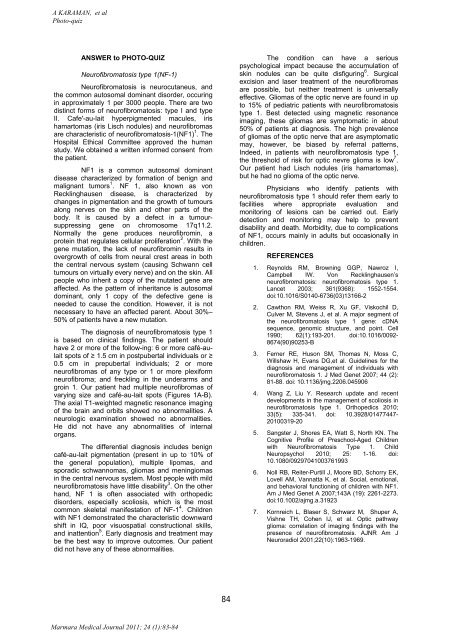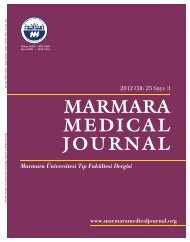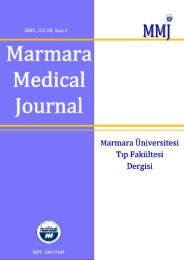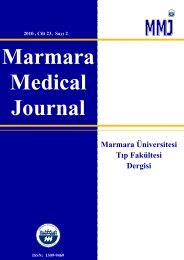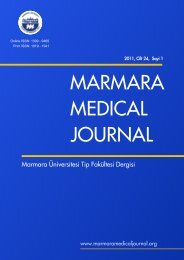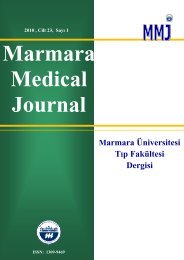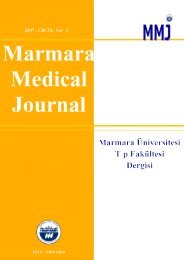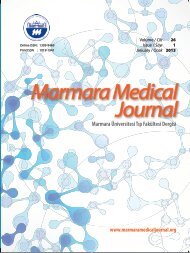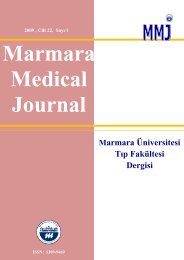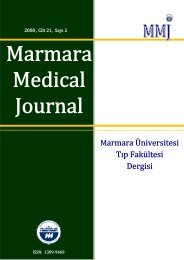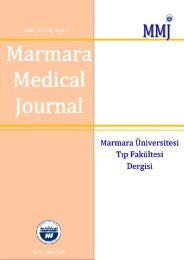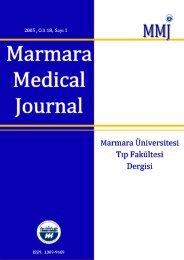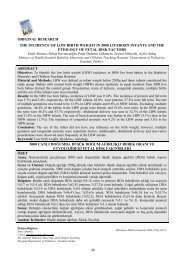Tam Metin PDF (4158 KB) - Marmara Medical Journal
Tam Metin PDF (4158 KB) - Marmara Medical Journal
Tam Metin PDF (4158 KB) - Marmara Medical Journal
- No tags were found...
You also want an ePaper? Increase the reach of your titles
YUMPU automatically turns print PDFs into web optimized ePapers that Google loves.
A KARAMAN, et alPhoto-quizANSWER to PHOTO-QUIZNeurofibromatosis type 1(NF-1)Neurofibromatosis is neurocutaneus, andthe common autosomal dominant disorder, occuringin approximately 1 per 3000 people. There are twodistinct forms of neurofibromatosis: type I and typeII. Cafe'-au-lait hyperpigmented macules, irishamartomas (iris Lisch nodules) and neurofibromasare characteristic of neurofibromatosis-1(NF1) 1 . TheHospital Ethical Committee approved the humanstudy. We obtained a written informed consent fromthe patient.NF1 is a common autosomal dominantdisease characterized by formation of benign andmalignant tumors 1 . NF 1, also known as vonRecklinghausen disease, is characterized bychanges in pigmentation and the growth of tumoursalong nerves on the skin and other parts of thebody. It is caused by a defect in a tumoursuppressinggene on chromosome 17q11.2.Normally the gene produces neurofibromin, aprotein that regulates cellular proliferation 2 . With thegene mutation, the lack of neurofibromin results inovergrowth of cells from neural crest areas in boththe central nervous system (causing Schwann celltumours on virtually every nerve) and on the skin. Allpeople who inherit a copy of the mutated gene areaffected. As the pattern of inheritance is autosomaldominant, only 1 copy of the defective gene isneeded to cause the condition. However, it is notnecessary to have an affected parent. About 30%–50% of patients have a new mutation.The diagnosis of neurofibromatosis type 1is based on clinical findings. The patient shouldhave 2 or more of the follow-ing: 6 or more café-aulaitspots of ≥ 1.5 cm in postpubertal individuals or ≥0.5 cm in prepubertal individuals; 2 or moreneurofibromas of any type or 1 or more plexiformneurofibroma; and freckling in the underarms andgroin 1. Our patient had multiple neurofibromas ofvarying size and café-au-lait spots (Figures 1A-B).The axial T1-weighted magnetic resonance imagingof the brain and orbits showed no abnormalities. Aneurologic examination showed no abnormalities.He did not have any abnormalities of internalorgans.The differential diagnosis includes benigncafé-au-lait pigmentation (present in up to 10% ofthe general population), multiple lipomas, andsporadic schwannomas, gliomas and meningiomasin the central nervous system. Most people with mildneurofibromatosis have little disability 3 . On the otherhand, NF 1 is often associated with orthopedicdisorders, especially scoliosis, which is the mostcommon skeletal manifestation of NF-1 4 . Childrenwith NF1 demonstrated the characteristic downwardshift in IQ, poor visuospatial constructional skills,and inattention 5 . Early diagnosis and treatment maybe the best way to improve outcomes. Our patientdid not have any of these abnormalities.The condition can have a seriouspsychological impact because the accumulation ofskin nodules can be quite disfiguring 6 . Surgicalexcision and laser treatment of the neurofibromasare possible, but neither treatment is universallyeffective. Gliomas of the optic nerve are found in upto 15% of pediatric patients with neurofibromatosistype 1. Best detected using magnetic resonanceimaging, these gliomas are symptomatic in about50% of patients at diagnosis. The high prevalenceof gliomas of the optic nerve that are asymptomaticmay, however, be biased by referral patterns,Indeed, in patients with neurofibromatosis type 1,the threshold of risk for optic nevre glioma is low 7 .Our patient had Lisch nodules (iris hamartomas),but he had no glioma of the optic nerve.Physicians who identify patients withneurofibromatosis type 1 should refer them early tofacilities where appropriate evaluation andmonitoring of lesions can be carried out. Earlydetection and monitoring may help to preventdisability and death. Morbidity, due to complicationsof NF1, occurs mainly in adults but occasionally inchildren.REFERENCES1. Reynolds RM, Browning GGP, Nawroz I,Campbell IW. Von Recklinghausen’sneurofibromatosis: neurofibromatosis type 1.Lancet 2003; 361(9368): 1552-1554.doi:10.1016/S0140-6736(03)13166-22. Cawthon RM, Weiss R, Xu GF, Viskochil D,Culver M, Stevens J, et al. A major segment ofthe neurofibromatosis type 1 gene: cDNAsequence, genomic structure, and point. Cell1990; 62(1):193-201. doi:10.1016/0092-8674(90)90253-B3. Ferner RE, Huson SM, Thomas N, Moss C,Willshaw H, Evans DG,et al. Guidelines for thediagnosis and management of individuals withneurofibromatosis 1. J Med Genet 2007; 44 (2):81-88. doi: 10.1136/jmg.2206.0459064. Wang Z, Liu Y. Research update and recentdevelopments in the management of scoliosis inneurofibromatosis type 1. Orthopedics 2010;33(5): 335-341. doi: 10.3928/01477447-20100319-205. Sangster J, Shores EA, Watt S, North KN. TheCognitive Profile of Preschool-Aged Childrenwith Neurofibromatosis Type 1. ChildNeuropsychol 2010; 25: 1-16. doi:10.1080/092970410037619936. Noll RB, Reiter-Purtill J, Moore BD, Schorry EK,Lovell AM, Vannatta K, et al. Social, emotional,and behavioral functioning of children with NF1.Am J Med Genet A 2007;143A (19): 2261-2273.doi:10.1002/ajmg.a.319237. Kornreich L, Blaser S, Schwarz M, Shuper A,Vishne TH, Cohen IJ, et al. Optic pathwayglioma: correlation of imaging findings with thepresence of neurofibromatosis. AJNR Am JNeuroradiol 2001;22(10):1963-1969.84<strong>Marmara</strong> <strong>Medical</strong> <strong>Journal</strong> 2011; 24 (1):83-84


